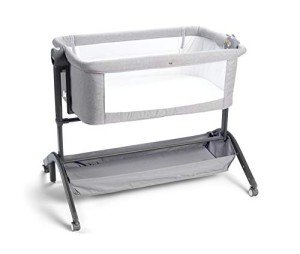What Baby Cot To Bed Experts Want You To Learn
페이지 정보
작성자 Valentina 작성일 25-07-31 03:06 조회 3 댓글 0본문
Transitioning from Baby Cot to Bed: A Comprehensive Guide for Parents
The journey from a baby cot to a bed marks a considerable turning point in a kid's development. It symbolizes self-reliance and an action toward maturing. However, this transition can often be daunting for both parents and kids. Comprehending the process, the best timing, and how to make the shift smoother can considerably help in this journey. This short article checks out the necessary to consider when transitioning your child from a cot to a bed, including common FAQs, ideas, and a structured strategy to make sure the process is as smooth as possible.

Why Transition from a Cot to a Bed?
Developmental Milestones
Transitioning to a bed is generally triggered by a number of aspects:
Physical Growth: As kids grow, they outgrow their Nursery cots. The average size for a convertible cot is typically implied for infants as much as 3 or 4 years of ages.
Cognitive Development: As toddlers become more curious and knowledgeable about their surroundings, they may attempt to climb up out of their cots, positioning safety dangers.
Potty Training: Once a kid is potty trained, they might require simpler access to the restroom, which a bed can help with.
Siblings: The arrival of a new brother or sister can also necessitate this shift, as the cot might need to be freed up.
When to Make the Transition
There is no one-size-fits-all answer to when a kid must transition from a cot to a bed. Nevertheless, here are some indications that it might be time:
- Climbing Out: If the child is trying to climb out frequently.
- Age Consideration: Many specialists advise this shift around the age of 2 to 3 years, although every kid is unique.
- Need for Independence: Children may express a desire for a big-kid bed.
Types of Beds Suitable for Toddlers
Not all beds are produced equivalent when it pertains to children. Here's a breakdown of suitable bed types:
| Bed Type | Description | Pros | Cons |
|---|---|---|---|
| Young child Bed | Smaller, lower to the ground, often with side rails. | Size-appropriate for young children; stability. | Limited life expectancy as they grow out of rapidly. |
| Single Bed | Standard size bed suggested for older children. | Lasts longer; can be utilized for several years. | Might be too big for a toddler; risk of falling. |
| Convertible Crib | Crib that changes into a young child bed. | Versatile; conserves money in the long run. | Can be pricey; some may not provide full-sized choices. |
| Loft Bed | Raised bed with area below for play or storage. | Optimizes space; enjoyable for kids. | Not appropriate for extremely young kids; safety concerns. |
Steps to Transition Smoothly
Transitioning to a bed can be made much easier with cautious preparation. Here's a step-by-step guide:
1. Prepare the Space
- Select a Location: Decide where the bed will be positioned.
- Childproof the Room: Since young kids are naturally curious, ensure that furniture is steady, sharp edges are covered, and harmful products run out reach.
- Keep Familiar Items: Retain preferred toys and bedding to provide convenience in the brand-new environment.
2. Introduce the Bed
- Involve Your Child: Let your kid assistance choose their bed or bedding to create excitement.
- Explain the Transition: Make them understand that they are ending up being a big kid by having a big-kid bed. Use encouraging language.
3. Make the Swap
- Bedtime Routine: Keep the bedtime regular consistent. This produces familiarity and comfort during the transition.
- Support: Offer them reassurance but prevent being extremely protective; it's important to motivate self-reliance.
4. Address Fears and Concerns
- Talk About Fears: Children might have fears of falling or the dark; discuss these freely.
- Reinforce Safety: Use guard rails on the bed initially and describe what to anticipate during the night.
5. Monitor and Adapt
- Be Patient: It might require time for your child to change completely.
- Stay Consistent: Maintain the nighttime routine, even when problems occur.
FAQs Regarding Transitioning from Cot to Bed
Q1: How long does the shift from a cot to a bed usually take?
A1: The shift can differ substantially among children-- ranging from a couple of days to a few weeks-- as they adjust to oversleeping a new space.
Q2: Should I buy a special toddler bed?
A2: Investing in a young child bed can make the transition simpler because they are developed with safety in mind; however, if you prefer to go directly to a single bed, that can work too with the best security procedures.
Q3: What if my kid keeps getting out of bed?
A3: This is normal! Encourage them to remain in bed and establish positive reinforcement by rewarding them for remaining in bed through the night.
Q4: Is it alright to shift to a huge bed too early?
A4: Transitioning too early can result in sleep interruptions. It's essential to examine the readiness of the child based on their signs and advancement.
Transitioning from a baby cot to a bed is a significant step for both kids and moms and dads. With thoughtful preparation and understanding of the kid's needs, moms and dads can make the shift smoother and more satisfying. By acknowledging when to make the transition, understanding the kinds of beds available, and preserving a constant routine, parents can minimize fears and cultivate a sense of security for their child during this interesting brand-new chapter. Ultimately, every kid is various, and persistence is crucial in making this journey a favorable experience.

댓글목록 0
등록된 댓글이 없습니다.



